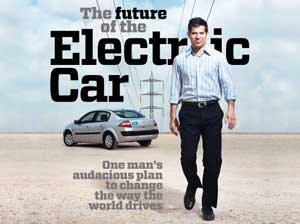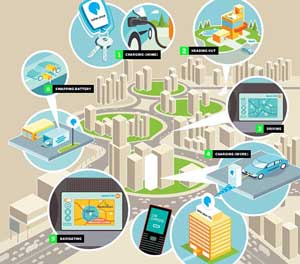(coming to you from a UAL jet somewhere en route from LA to Boston...)
 Wired's cover story this month is The Future of the Electric Car, about Shai Agassi and his company Better Place. He has a pretty innovative vision. Instead of building electric cars and selling them, he wants to build a network of charging stations and give cars away, then charge for access to the network. A sort of weird melding of the business model of cellular phones with the technology of electric cars. One advantage of this approach is that range isn't as much of an issue; if you could charge your car "everywhere", how far would it have to be able to go on a charge? Wired's cover story this month is The Future of the Electric Car, about Shai Agassi and his company Better Place. He has a pretty innovative vision. Instead of building electric cars and selling them, he wants to build a network of charging stations and give cars away, then charge for access to the network. A sort of weird melding of the business model of cellular phones with the technology of electric cars. One advantage of this approach is that range isn't as much of an issue; if you could charge your car "everywhere", how far would it have to be able to go on a charge?
{I have one of the longest commutes to my office of anyone I know, 140 miles. That is easily possible with many electric car designs. It is trying to make them go 300 miles which is tough.}
From the Wired article:
Agassi dealt with the battery issue by simply swatting it away. Previous approaches relied on a traditional manufacturing formula: We make the cars, you buy them. Agassi reimagined the entire automotive ecosystem by proposing a new concept he called the Electric Recharge Grid Operator. It was an unorthodox mashup of the automotive and mobile phone industries. Instead of gas stations on every corner, the ERGO would blanket a country with a network of "smart" charge spots. Drivers could plug in anywhere, anytime, and would subscribe to a specific plan—unlimited miles, a maximum number of miles each month, or pay as you go—all for less than the equivalent cost for gas. They'd buy their car from the operator, who would offer steep discounts, perhaps even give the cars away. The profit would come from selling electricity—the minutes.
 A key is the AutOS (diagramed at right, click to enlarge), the network which provides electricity to the cars. A key is the AutOS (diagramed at right, click to enlarge), the network which provides electricity to the cars.
-
-
-
-
-
-
| 



